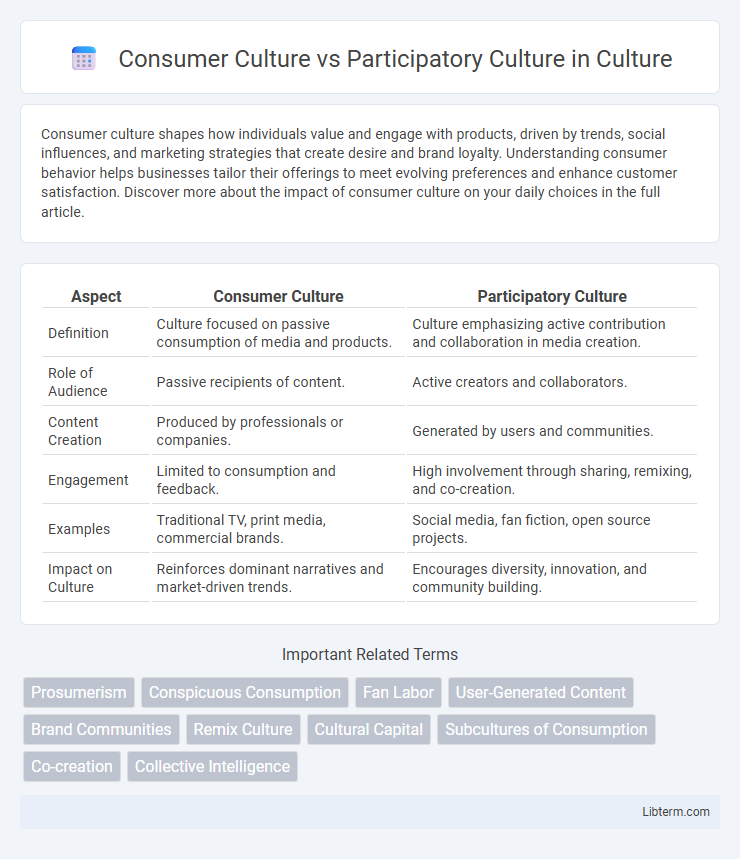Consumer culture shapes how individuals value and engage with products, driven by trends, social influences, and marketing strategies that create desire and brand loyalty. Understanding consumer behavior helps businesses tailor their offerings to meet evolving preferences and enhance customer satisfaction. Discover more about the impact of consumer culture on your daily choices in the full article.
Table of Comparison
| Aspect | Consumer Culture | Participatory Culture |
|---|---|---|
| Definition | Culture focused on passive consumption of media and products. | Culture emphasizing active contribution and collaboration in media creation. |
| Role of Audience | Passive recipients of content. | Active creators and collaborators. |
| Content Creation | Produced by professionals or companies. | Generated by users and communities. |
| Engagement | Limited to consumption and feedback. | High involvement through sharing, remixing, and co-creation. |
| Examples | Traditional TV, print media, commercial brands. | Social media, fan fiction, open source projects. |
| Impact on Culture | Reinforces dominant narratives and market-driven trends. | Encourages diversity, innovation, and community building. |
Understanding Consumer Culture: Definition and Key Traits
Consumer culture centers on the acquisition and consumption of goods and services as a primary means of identity formation and social status. Key traits include passive consumption, brand loyalty, and the influence of advertising shaping desires and behaviors. This culture emphasizes material wealth, mass media consumption, and a marketplace-driven lifestyle where individual choice is often guided by commercial interests.
The Rise of Participatory Culture: Meaning and Characteristics
Participatory culture emphasizes active engagement, where individuals create, share, and collaborate on content rather than passively consuming it, contrasting sharply with consumer culture's focus on unidirectional consumption. Key characteristics include low barriers to artistic expression, strong social connection among participants, and an environment fostering mentorship and collective intelligence. This culture thrives in digital spaces like social media and online communities, empowering users to influence media narratives and cultural trends directly.
Historical Evolution: From Passive Consumers to Active Participants
Consumer culture historically emphasized passive consumption of pre-produced media and goods, where audiences had limited influence over content creation. The rise of digital technologies and social media platforms catalyzed a shift towards participatory culture, enabling users to actively contribute, share, and co-create cultural products. This evolution reflects a transformative move from one-way consumption to interactive engagement, empowering audiences as both consumers and producers in the cultural landscape.
Media Influence on Consumer and Participatory Cultures
Media influence shapes consumer culture by promoting passive consumption through targeted advertising and mass media content that encourages materialism and brand loyalty. In contrast, participatory culture thrives on interactive media platforms where users actively create, share, and collaborate, empowering audiences to influence media narratives and cultural production. The shift from one-way communication to interactive engagement redefines media's role from mere consumption to co-creation, fostering community building and collective identity.
Power Dynamics: Who Controls the Narrative?
Consumer culture centralizes control of narratives within corporations and media conglomerates, shaping public perception through top-down messaging and commodified content. Participatory culture shifts this power balance by empowering individuals to create, share, and influence narratives collaboratively, fostering decentralized storytelling and diverse viewpoints. Digital platforms like social media and user-generated content sites are pivotal arenas where these competing power dynamics play out.
Digital Technologies and the Shift Toward Participation
Digital technologies have transformed traditional consumer culture into participatory culture by enabling users to actively create, share, and engage with content rather than passively consuming it. Platforms like social media, blogs, and video-sharing sites empower individuals to contribute to cultural production, fostering collaboration and collective intelligence. This shift democratizes media access and blurs the line between producers and consumers, driving innovation and community-driven creativity.
Consumerism vs. Collaboration: Economic and Social Impacts
Consumer culture emphasizes passive consumption of goods and media, driving economic growth through continuous demand and fueling corporate profits, yet often leading to social isolation and environmental degradation. Participatory culture fosters active collaboration and co-creation among individuals, promoting shared knowledge, community engagement, and innovation that can democratize information and create social capital. The economic impact of participatory culture includes decentralized content production and new business models, while socially it enhances collective identity and empowerment, contrasting with the top-down economic and social effects of consumerism.
Brand Engagement: Consumers as Fans, Critics, and Co-Creators
Consumer culture traditionally positions individuals as passive recipients of brand messages, where engagement is limited to consumption and occasional feedback. Participatory culture transforms consumers into active fans, critics, and co-creators, fostering deeper brand loyalty through interactive campaigns, user-generated content, and collaborative product development. This shift enhances brand engagement by enabling consumers to influence brand narratives, participate in community-building, and co-create value alongside companies.
Challenges and Criticisms of Consumer and Participatory Cultures
Consumer culture faces criticism for promoting passive consumption and reinforcing mass media's control over individual choices, leading to diminished critical thinking and creativity. Participatory culture, while lauded for fostering collaboration and user-generated content, encounters challenges including digital divide issues, intellectual property conflicts, and potential exploitation of unpaid labor. Both cultures grapple with balancing individual agency and corporate influence amidst rapidly evolving technological landscapes.
Future Trends: Blending Consumption and Participation in Society
Emerging trends highlight a convergence of consumer culture and participatory culture as digital platforms enable users to actively shape products, services, and media content. The rise of user-generated content, co-creation models, and interactive marketing strategies reflects a shift toward collaborative consumption that blurs traditional boundaries between producers and consumers. Innovations in virtual reality, social commerce, and blockchain technology will drive deeper integration of participation and consumption, fostering communities where engagement directly influences market offerings and cultural production.
Consumer Culture Infographic

 libterm.com
libterm.com